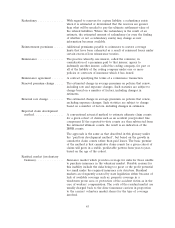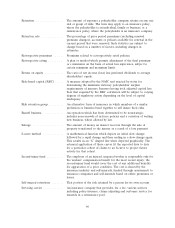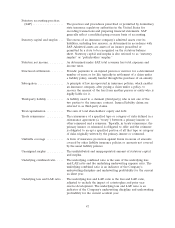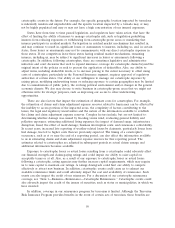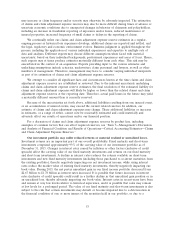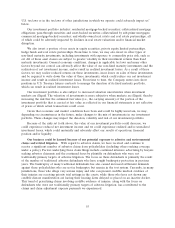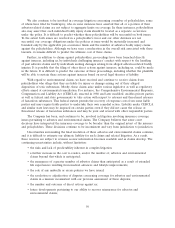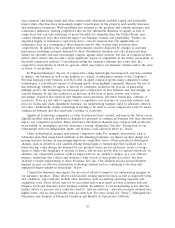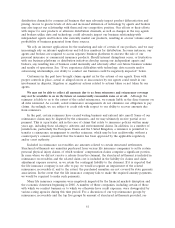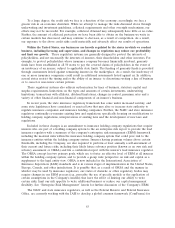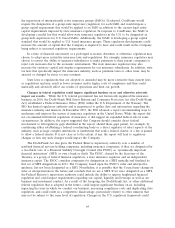Travelers 2015 Annual Report Download - page 55
Download and view the complete annual report
Please find page 55 of the 2015 Travelers annual report below. You can navigate through the pages in the report by either clicking on the pages listed below, or by using the keyword search tool below to find specific information within the annual report.U.S. tax laws or in the tax laws of other jurisdictions in which we operate could adversely impact us’’
below.
Our investment portfolio includes: residential mortgage-backed securities; collateralized mortgage
obligations; pass-through securities and asset-backed securities collateralized by sub-prime mortgages;
commercial mortgage-backed securities; and wholly-owned real estate and real estate partnerships, all
of which could be adversely impacted by declines in real estate valuations and/or financial market
disruption.
We also invest a portion of our assets in equity securities, private equity limited partnerships,
hedge funds and real estate partnerships. From time to time, we may also invest in other types of
non-fixed maturity investments, including investments with exposure to commodity price risk, such as
oil. All of these asset classes are subject to greater volatility in their investment returns than fixed
maturity investments. General economic conditions, changes in applicable tax laws and many other
factors beyond our control can adversely affect the value of our non-fixed maturity investments and the
realization of net investment income, and/or result in realized investment losses. As a result of these
factors, we may realize reduced returns on these investments, incur losses on sales of these investments
and be required to write down the value of these investments, which could reduce our net investment
income and result in realized investment losses. From time to time, the Company enters into short
positions in U.S. Treasury futures contracts to manage the duration of its fixed maturity portfolio,
which can result in realized investment losses.
Our investment portfolio is also subject to increased valuation uncertainties when investment
markets are illiquid. The valuation of investments is more subjective when markets are illiquid, thereby
increasing the risk that the estimated fair value (i.e., the carrying amount) of the portion of the
investment portfolio that is carried at fair value as reflected in our financial statements is not reflective
of prices at which actual transactions could occur.
Given that economic and market conditions have been and could be highly uncertain, we may,
depending on circumstances in the future, make changes to the mix of investments in our investment
portfolio. These changes may impact the duration, volatility and risk of our investment portfolio.
Because of the risks set forth above, the value of our investment portfolio could decrease, we
could experience reduced net investment income and we could experience realized and/or unrealized
investment losses, which could materially and adversely affect our results of operations, financial
position and/or liquidity.
Our business could be harmed because of our potential exposure to asbestos and environmental
claims and related litigation. With regard to asbestos claims, we have received and continue to
receive a significant number of asbestos claims from policyholders (including others seeking coverage
under a policy). Factors underlying these claim filings include continued intensive advertising by lawyers
seeking asbestos claimants and the continued focus by plaintiffs on defendants who were not
traditionally primary targets of asbestos litigation. The focus on these defendants is primarily the result
of the number of traditional asbestos defendants who have sought bankruptcy protection in previous
years. The bankruptcy of many traditional defendants has also caused increased settlement demands
against those policyholders who are not in bankruptcy but remain in the tort system. Currently, in many
jurisdictions, those who allege very serious injury and who can present credible medical evidence of
their injuries are receiving priority trial settings in the courts, while those who have not shown any
credible disease manifestation are having their hearing dates delayed or placed on an inactive docket.
This trend of prioritizing claims involving credible evidence of injuries, along with the focus on
defendants who were not traditionally primary targets of asbestos litigation, has contributed to the
claims and claim adjustment expense payments we experienced.
55


